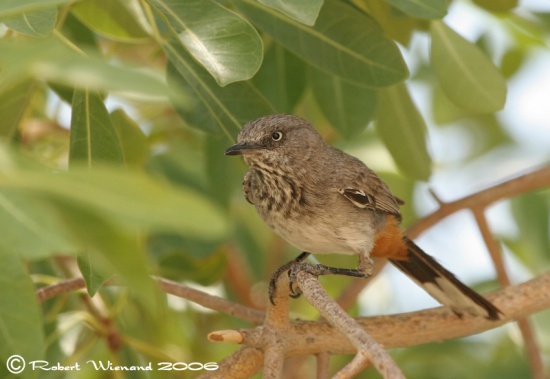m |
m |
||
| Line 30: | Line 30: | ||
{{ref}} | {{ref}} | ||
==External Links== | ==External Links== | ||
| − | {{GSearch|Sylvia+ | + | {{GSearch|Sylvia+subca}} |
[[Category:Birds]] [[Category:Sylvia]] | [[Category:Birds]] [[Category:Sylvia]] | ||
Revision as of 18:37, 24 October 2016
Alternative Names: Chestnut-vented Tit-babbler, Rufous-vented Warbler
- Sylvia subcoerulea
Identification
14-15 cm. Grey brown upperparts, black tail with a broad white band at its tip, white eye ring, grey throat is with heavy dark streaking, grey breast and belly, and the vent area is bright chestnut. Black legs and grey eyes. The sexes are similar, but the juvenile has an unstreaked throat.
Distribution
Angola, Botswana, Zimbabwe, Zambia, Namibia, South Africa, Lesotho, Mozambique and Swaziland. Southern Africa (except wetter e and ne parts) to Angola.
Taxonomy
Sylvia subcaerulea has four subspecies:[1][2]
- S. s. ansorgei
- Coastal south-western Angola
- S. s. cinerascens
- S. s. subcoerulea
- Western, southern and central South Africa
- S. s. orpheana
- Zimbabwe to eastern South Africa and Lesotho
Formerly placed in the genus Parisoma.
Habitat
Thornveld, riverine bush and scrub, semi-arid scrub, bushy hillsides, thickets in savanna.
Behaviour
Its diet includes insects and small invertebrates. Breeding: Season: August to December in sw Cape, August to March (mainly October-December) in Transvaal, October to January in KwaZulu-Natal, September to March (mainly September-November) in Zimbabwe, December to April in sw Kalahari (where probably partly opportunistic after rain). Nest: Thin-walled cup of dry grass, rootlets and spider web, lined with fine plant fibres and down.
References
- Clements, J. F., T. S. Schulenberg, M. J. Iliff, B.L. Sullivan, C. L. Wood, and D. Roberson. 2013. The eBird/Clements checklist of birds of the world: Version 6.8., with updates to August 2013. Downloaded from http://www.birds.cornell.edu/clementschecklist/download/
- Hockey, PAR, WRJ Dean, and PG Ryan, eds. 2005. Roberts' Birds of Southern Africa. 7th ed. Cape Town: John Voelcker Bird Book Fund. ISBN 978-0620340533
Recommended Citation
- BirdForum Opus contributors. (2024) Chestnut-vented Warbler. In: BirdForum, the forum for wild birds and birding. Retrieved 24 April 2024 from https://www.birdforum.net/opus/Chestnut-vented_Warbler




